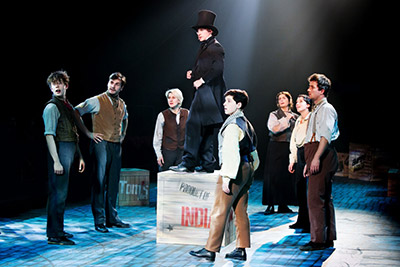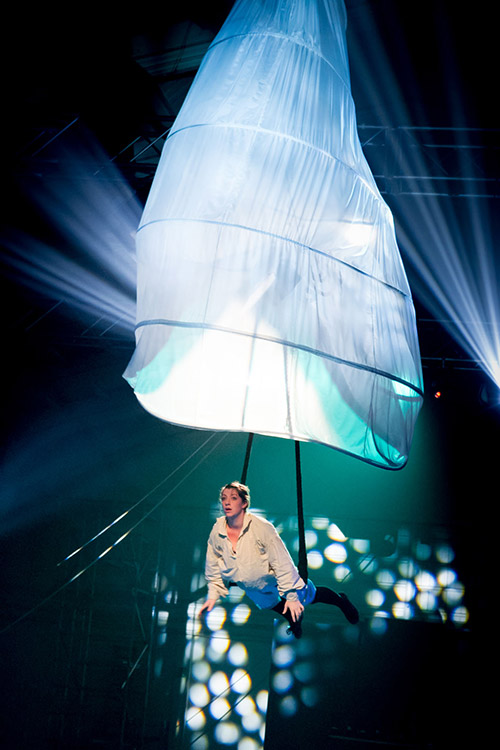23-02-2015
Fineline Walks The Chains to Celebrate the Engineering Genius of Brunel
Bristol based lighting, visuals and rigging specialist Fineline supplied lighting and rigging equipment and expertise in a series of creative solutions for the world premiere of ‘Walking The Chains’, an ambitious circus / theatre production staged in the historic Passenger Shed at Bristol Temple Meads Station.

Celebrating 150 Years of Isambard Kingdom Brunel’s iconic Clifton suspension bridge, its spirit and impact as a landmark of Victorian engineering from conception to completion, the narrative also recalled how the bridge integrated into the community and industrial history of the region. The show was a collaboration between Bristol’s Show of Strength Theatre Company and circus / physical theatre performance company, Circomedia.
The show’s designer James Helps contacted Fineline on the recommendation of several others – to provide the solutions needed to stage the show - and its essential requirement to replicate the bridge in a theatrical setting - in this unique site specific location.
“We were all very pleased to be involved” comments Fineline’s Rob Sangwell, “Apart from the obvious respect for Brunel and his many great civil engineering projects, it
was great to be involved in a local production that was imaginative, different and required plenty of brainwork to create elegant solutions”.
A major challenge was the fragile timber beam work in the roof of the building, which has never been used in such a context before, and had a weight loading of just 150 Kgs per point. The Passenger Shed was designed by Brunel as part of his ‘Old Station’ prior to the construction of Temple Meads Station itself. It contained two long platforms with rail tracks in the centre and was where passengers embarked the carriages that were pulled to the locomotives.
The show was played in traverse, a configuration perfectly suited to the narrative as well as the layout of the building, with two sets of bleacher seating stands installed either side of the long since removed railway tracks. The sides of the room also represented the gorge, and the centre space the River Avon which the bridge spans.
Rob Sangwell and Reuben Pinkney pooled their vast knowledge and considerable enthusiasm for the project to design a large ground support rigging system that provided both lighting, set and audio positions, and also a combined flown / ground supported truss grid for the aerial performance elements of the show.
The six legged 15 x 25 metre ground support was built from 52cm Supertruss and tailored to the space to provide most of the equipment positions. The aerial performance grid – complete with Circomedia’s pulleys, flaying harnesses, winches, rope trapezes, etc. - was dead hung from the roof timbers after being lifted into position using 9 x CM ProStar motors, all positioned to spread the load. The Supertruss aerial grid was additionally supported by two ground based towers taking most of the weight.
The ground support gave 7 metres of headroom, with the flying rig at 8 metres, out of a maximum headroom of 9 metres to the top of the apex roof.
The floor underneath what had originally been the rail tracks, was braced with a bespoke timber structure which allowed a self-elevating tightrope system to be installed by Circomedia, which was one of the props used for stunts and actors crossing the bridge.
Lighting designer Mark Dymock has worked with ‘Walking The Chains’ director Robin Belfield on a number of occasions, but this was the first time he had encountered Fineline, an experience he describes as “Excellent” in all respects.
His main creative goal was to make the vast space of the Passenger Shed come alive and wrap the audience up in the action.
Rather than throwing lots of kit at it to cover the space, it was more a case of choosing precisely the right kit and making each fixture work extremely hard.

Fineline supplied 12 x Robe Pointe multi-purpose fixtures which were the core of the lighting rig and positioned all around the ground support structure. They met the ‘powerful and flexible’ criteria, and were utilised for effects like recreating the chains of the bridge with their beams, plus washes and breakup effects.
He also specified 12 x Robe LED Wash 600s, four of which were rigged per side on the long edges of the ground support with four along the centre beam. These were used for general washes and for specials during some of the aerial sections.
The action flipped back and forth in time between the 1860s and the present, a storytelling vehicle which was reinforced with colour shifts, another reason Mark selected LED Washes as they are great for all the subtle hues as well as all the bold saturates.
The moving light count was completed with four Robe ROBIN 600E Spots positioned half way up on four of the ground support legs, and used to capture the aerialists in action and a range of other effects.
The moving lights did most of the work and were augmented by a selection of well-placed generics – ETC Source Fours, PARs and floods.
Fineline’s Stuart England crunched the numbers to work out the vast cable runs needed to distribute the lighting cabling around the venue and co-ordinated rigging the lighting on site.
Production designer James Helps sums up “Working with Fineline was amazing and brought invaluable skills, knowledge and imagination – and more extremely pleasant people - to the table. Their commitment to the production was really impressive and in fact, far more than expected as their whole team embraced the vibe and adventure of the show”.
